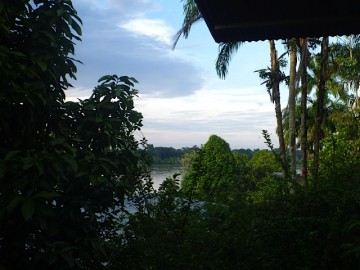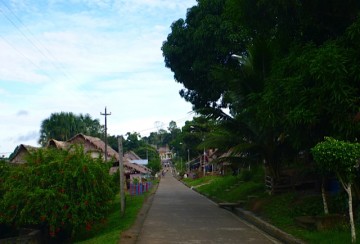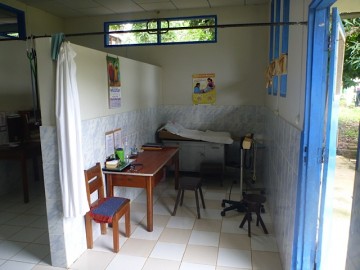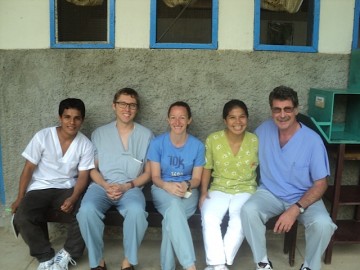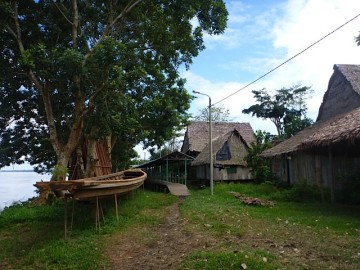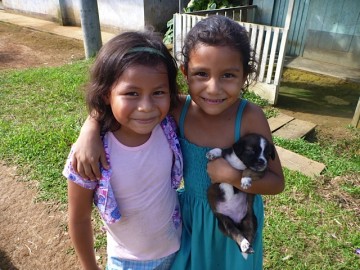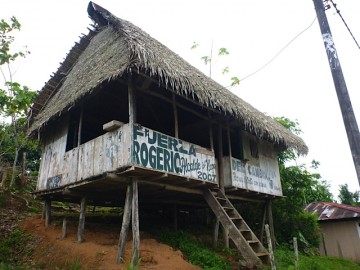“St. Clotilde Travels”
by Michael Slatnik
Arrival: January 3, 2012
Happy new year to you all! As many of you know i’m spending January learning and working in a small hospital in the Peruvian jungle, in Santa Clotilde. I’ve been here a few days now and I”ll try to send semi-regular updates. I landed in Lima on Dec 28 and spent the night in Lima with Padre Moe, chatting and learning about the history of the health centre. On the 29th I flew to Iquitos. It’s a city of almost 500,000 in northeast Peru, and the largest city in the world that you can’t reach by car (only by plane or by river). I didn’t have much time to see Iquitos as the next day I was off early in the morning to catch my first of two boats to get to Santa Clotilde. I was told to be ready at 6, and as a good Canadian I was ready and packed at 5:55, and the boat didn’t end up leaving until 9. The boat was full of people with one seat empty, and everyone was chattering; from what I could gather, the person that was missing had drunk-dialed almost everyone on the boat between 2 and 4 am, and no one was able to get a hold of him in the morning, but they were waiting because he was the only remaining family member not on the boat. Sheepishly, he ran down the dock and caught the boat just as we were about to leave without him. I had my first look at the Amazon river, which is unbelievably huge, at least 1km across, and I was told it grows to 3 times the size at its peak, in November.
The trip starts off with a quick 1-hour boat ride down the Amazon to a place called Mazan, where the Amazon and Napo rivers are very close, where you hop off the boat, moto-taxi to the other side of town, wait 90 minutes, and hop onto another boat going up the Napo river. This is then a 4-hour ‘rapido’ upriver to Santa Clotilde. Along the way, it’s a wide river with beautifully lush jungle all around, where the boat driver dodges entire floating trees, and the communities on either side look like idyllic jungle village movie sets. My boat was full of gigantic loudspeakers and instruments, as well as musicians coming to play for new years eve in St Clotilde. One of them thought I looked like Harry Potter, and announced to the whole boat that his dreams have come true, Harry Potter has arrived! I was really confused and so were most people (I have blond hair), but it was hilarious. He was the lead singer, just warming up his stage persona I think.
Santa Clotilde is a community of almost 5000 people on the Napo river. The Centro de Salud de St Clotilde was founded in 1986 by two physician-priests, Padre Jack and Padre Moe, from the US and Canada. It has grown along with the town through the hard work and dedication of both doctors and staff, and currently provides primary-care clinic, hospital, dental, vaccines, and obstetric care to St Clotilde as well as the communities up and down river. Currently Padre Moe lives in Lima full-time and Padre Jack is transitioning out of the role of medical director, to find a sustainable staffing model for the health centre. Padre Jack is in the US for a few weeks, and a young Peruvian physician named Juan is currently the medical director. There are two other young Peruvian doctors, one trained in Cuba and one in Peru. There’s also a medical student from Chicago, and a dentist from Lima. We all live in a hostel-like place about 50m up from the hospital, with a common eatery and living-room and individual rooms.
Last night was new years eve, and we planned a big dinner. I skipped lunch and just had a light lunch in anticipation of this epic feast, and then I learned that it’s custom to eat new years dinner right at midnight. My stomach dropped. We hung out and had champagne. At 1130 we were seated at the table with food in front of us, salivating, having another toast and waiting to eat, when a nurse screamed from below that there was an emergency. We all changed in to scrubs and Juan performed a successful emergency c-section. We had our midnight countdown in the operating room with him right about to begin the surgery. The baby was born just after midnight, the first St Clotilde baby of 2012. Throughout the operation people kept popping their heads into the OR and wishing us happy new years, which wasn’t exactly sterile operating conditions but it made it quite fun. We then had our new years dinner at 230 and sat around until 5. All in all, a pretty awesome new years.
Week two: January 10, 2012
Greetings from Peru!
I’m in my second week of work here in St Clotilde, and setting into the rhythms of life and work. Days start at 8, when we round on every patient in the hospital with the whole health care team of doctors, nurses, dentist, midwife, lab techs and admin staff. There are about 20 workers on any given day, and about 20 patients in hospital. A lot of care goes into keeping patients comfortable with what resources are available. After rounds I sit in my consultorio and see patients until about 2, when we have lunch (almuerzo) and then relax and try to nap, because it’s hotter than hell in the afternoon. When it rains it cools down, and it’s delightful. Whoever is on call sees emergency patients for the rest of the day and night, and attends to any inpatient needs, and everyone else can relax. We’ve been quite busy this past week. Some staff had to leave because the government wasn’t actually paying them for the last two months so they had to go into town to sort out their paycheques. I’m told it’s unfortunately an all too common occurrence in Peru to not have your paycheque come through. This past week we’ve only had Dr Juan, myself, and Erin, a medical student from Chicago. Being on call every third night is always taxing, but it’s better than 1 in 2. It’s also a lot of responsibility for our medical student Erin, but her spanish is perfect and she’s doing well. By next week we’ll have 3 more doctors, so life will once again be bakan!
The medicine here is super interesting as there’s tons of diseases i’ve only ever read about, or haven’t ever read about, like weird and wonderful parasites and tropical infectious diseases. There are some language barriers in terms of working in Spanish, but it’s going well. Some things i’ve learned so far are that everyone has parasites so make sure you check, delivering a baby in a canoe at night is dangerous, kids shouldn’t be able to play with machetes, and you have to be well aware of what hours there is and isn’t electricity (our room turned pitch black right as a woman was about to deliver a baby, and we had to fumble to find flashlights). It’s a very comfortable life here though, we’re well fed, it’s clean, and unbelievably, there’s wifi. A series of towers were built at ~50K intervals all along the Napo river by the Gates foundation, for the purposes of the Napo river health network. There are about 4 ‘Centros de Salud’, staffed by a doctor, and about 10 ‘Puestos de Salud’, staffed by medical technicians, in this network, up and down river. They’re all connected by skype and it’s a little experiment in telemedicine, chatting with health workers across the network and being able to do medical consults by video. It’s a low tech but very powerful tool, and a really cool thing to experience.
Week 4: January 26, 2012 “Reflections”
Just as I am starting to feel comfortable in working in this place, and happy that I am understanding the complexities of the local social and geographical barriers to health, it’s time to go home. The last few weeks have been filled with the rhythm of work and life here in St Clotilde. In the first two weeks I spent my afternoons walking and doing my best to exercise, but lately i’ve succumbed to the will of the jungle and slept the afternoons away (or, when it hasn’t rained that day, sweated the afternoons away and questioned the cruelty of the heat).
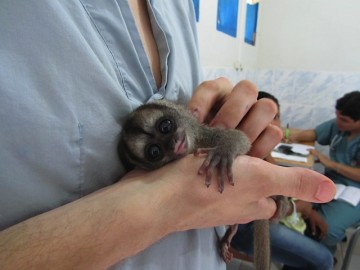
A lady came into clinic with a monkey living in her hair, and let me keep it company while she had her consult. When it’s a little baby she breast-feeds it, then it just lives on her head, eating, peeing, etc. I want one. Quite possibly, the best head accessory since the invention of the hat.
It’s certainly been a month of new experiences. I had an opportunity a few weeks back to try Mosato (a jungle liquor made from yuca). I was offered a warm, tall glass of it, and as I drank the whole thing I tried to forget how it’s made: women chew yuca and spit it into a large bucket, where it ferments, turning into the liquor. I’ve learned that no matter how hot it is, cold showers are still cold. After my first week here I noticed my bag looked dirty, and I thought somewhere along the river journey it was splashed with mud or river water of some sort. Somehow, it got dirtier and dirtier without moving at all, which is when I learned that it’s just mold. Mold grows on everything here, and a little soap and water and sun will set things right.
The medicine here is very challenging but very interesting, and an incredible learning experience. Occasionally while on call you take calls from communities far upriver, and have to practice medicine over the phone, in Spanish, over a connection which is very scratchy, using only a fraction of the medicines that you know. Wow, that’s a lot of variables! It is however very rewarding when you can take what you consider to be the world’s best evidence-based medicine and apply it to a community so far removed from the world you know, to make a positive difference in someone’s life. Spending time here has taught me that despite available resources, your approach and intentions to any given patient can be the same no matter where you work. There is a certain level of basic supplies and medications necessary to provide quality care, and with those ingredients at St Clotilde, high quality health care can be provided to a population in need. It’s been an honor and a pleasure to pass a month here, and i’m looking forward to being able to come back! Now off to Iquitos and Lima, for the pizza and air-conditioning that i’ve been dreaming of for a month.
Thanks Santa Clotilde.
Michael Slatnik is an R2 in the UBC Rural Family Practice Residency Program.
